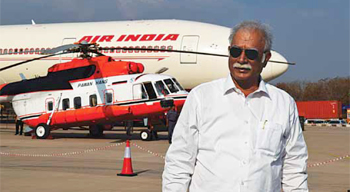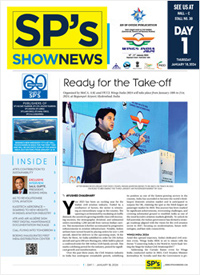- Prime Minister Narendra Modi inaugurates Aero India 2023 in Bengaluru; Releases Commemorative Stamp
- Defence Secretary meets delegations from Saudi Arabia, USA and Oman on the sidelines of Aero India 2023
- Foreign Ministers of 32 countries to attend Aero India 2023
- Embraer showcases the C-390 Millennium at Aero India 2023
Civil Aviation Policy to be out in April 2016
 The much-awaited civil aviation policy would be announced by April, 2016, the Civil Aviation Minister P. Ashok Gajapati Raju at the press conference at India Aviation 2016. The Cabinet is expected to give the nod soon to the policy which has many components to promote civil aviation in India.
The much-awaited civil aviation policy would be announced by April, 2016, the Civil Aviation Minister P. Ashok Gajapati Raju at the press conference at India Aviation 2016. The Cabinet is expected to give the nod soon to the policy which has many components to promote civil aviation in India.
“The work on the new aviation policy is in an advanced stage. We have put out the draft policy in the public domain. We are now seeking the guidance of senior Ministers. The new policy will be out by April this year,” the Minister said in an interaction with the media. The aviation policy covers a wide gamut of issues including taxation and simplification of procedures to achieve the goal of making India a global aviation hub in the coming years. “There are 22 items in the draft policy and some of them have implications on the growth of the sector. Our idea is to give a boost to the entire ecosystem so that air connectivity in the country improves substantially,” Gajapathi Raju said.
The Minister admitted that India has the highest ATF (aviation turbine fuel) tax in the world and said despite the fall in the international prices of aviation fuel the benefit has not been passed on to the airlines. “We are still the highest price of ATF in the world, but at the same time we have the highest passenger growth in the world.” However, foreign airlines flying out of India would have no VAT (value added tax) and no excise duty. It is zero.” This is peculiar to India and we have to look at the bilateral air services agreement with different countries.
5/20 Rule, government has plan
The proposed policy will address this issue along with the restrictive 5/20 rule for operating international flights. “Once cleared by the cabinet, the policy will be unambiguous on this issue,” the Minister said. The Civil Aviation Secretary, R.N. Choubey said that the Ministry had received substantial inputs on the 5/20 rule, both favouring and opposing. Weighing all options, the government will take the right decision soon.
MRO Push
On MRO sector, the Minister said this was being given a policy push and issues such as taxation, customs duty and VAT were all being revisited. Once the MROs come, there will be quick turnaround of aircraft and also it will bring in revenues. “About $700 million of business can come into India.” The MROs would given fiscal concessions. With regard to the slow start of Air India’s MRO in Nagpur. ‘It took long years to come. There were problems and one of which was access, clearly visible. We have rectified that problem. There is talent in Nagpur and I am optimistic that it will be in full use soon.”
General Aviation /Business Aviation need to comeforth
Asked about issues to do with GA/BA, the Minister said they had not approached him as yet and they were ‘most welcome’ to bring forth their issues such that they can be resolved. So also scheduled airlines could approach him anytime. The Secretary said there is ‘no policy bottleneck’ with regard to GA/BA and market forces would decide on their viability.
Answering a question on Air India’s debts, Gajapati Raju said that it was first time that the company had reported operating profits and was well on course to recovery. Disagreeing with a questioner drawing parallel between Air India and the debt-ridden King Fisher airlines, the Minister said, “Air India has not cheated anyone. In fact, it has not defaulted on the payments. The debts have been accumulated over years.”
Kingfisher giving a bad name
What happened with Kingfisher Airlines, he said ‘should never have happened. It has given airlines a bad name and increased leasing costs.”
The turnaround plan for Air India was working exceedingly well and it has been making consistent operational profits since December last. Air India is now expected to post net profit by 2019, about one-and-half years ahead of the original deadline worked out as per the turnaround plan. The capital infusion for Air India has been on an average around 2,500 crore.
Regional connectivity, game-changer
The biggest game changer for the country’s civil aviation sector would come when the government’s plans for improving regional connectivity by reviving the unused air strips across the country. The idea is to make air travel affordable for a major chunk of an estimated 350 million people belonging to middle class. “In our draft policy, we have proposed to add 50 airports every year by reviving the air strips that are now lying idle. For this, we are offering a series of incentives to the operators including viability gap funding to ensure connectivity between smaller towns and the big cities. The idea is to see that a passenger pays not more than 2,500 for air travel for a distance of 500 km,” the Aviation Secretary said.
Choubey said that it was heartening to note that almost all the airframers are here at India Aviation and that they have been specifically told to create an eco-system and not just sell an aircraft. The eco-system for the airframer comprised selling the aircraft; creating MRO facility; simulation and training facilities and leasing options. “This has been made clear to all the airframers.”
Expressing happiness over the enthusiastic response to the fifth edition of India Aviation event, he said that 25 countries were participating in the event while seven states have partnered with the union civil aviation ministry for the show. As many as 210 companies are represented at the show while 29 aircraft are on display. Two partner countries at India Aviation 2016 are the United States and Canada.





